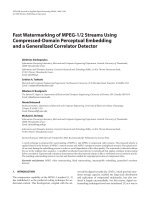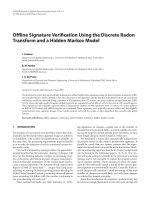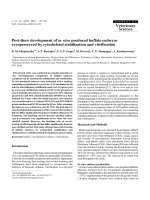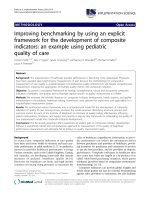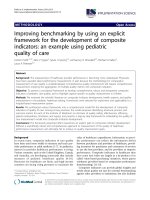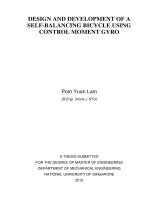Development of nutrient rich extruded product using rice, finger millet, soybean and mango seed kernel flour
Bạn đang xem bản rút gọn của tài liệu. Xem và tải ngay bản đầy đủ của tài liệu tại đây (494.26 KB, 10 trang )
Int.J.Curr.Microbiol.App.Sci (2020) 9(7): 1207-1216
International Journal of Current Microbiology and Applied Sciences
ISSN: 2319-7706 Volume 9 Number 7 (2020)
Journal homepage:
Original Research Article
/>
Development of Nutrient Rich Extruded Product using Rice, Finger Millet,
Soybean and Mango Seed Kernel Flour
P. S. Sapariya*, V. P. Sangani and M. H. Muliya
Department of Processing and Food Engineering, College of Agricultural Engineering and
Technology, Junagadh Agricultural University, Junagadh, Gujarat, India-362001
*Corresponding author
ABSTRACT
Keywords
Extruded product,
Nutrient, Finger
millet, Soybean and
Mango Seed Kernel
Article Info
Accepted:
11 June 2020
Available Online:
10 July 2020
Extrusion cooking is the technology, which transforms raw ingredients into ready-to-eat
products, which is known as extruded product. Blends of different flours were used (i.e.
rice, soybean, finger millet and mango seed kernel flour) in different proportion to increase
the commercial value of extruded product. Study focuses to obtain desired proportion of
rice, soybean, finger millet and mango seed kernel flour, determined the physical,
functional, biochemical and sensory properties and increase the nutritional value of
extruded product for acceptance of customer. The research were done at die temperature
(120°C), screw speed (275 rpm) and feed moisture content (18 % w.b.) as independent
variables. Depending on sensory evaluation of the prepared extruded products, the feed
composition was fixed as 75 % rice, 5 % finger millet, 7.5 % soybean and 12.5 % mango
seed kernel flour. Extruded product prepared from decided feed composition increases true
protein of 35.15 % over control sample.
Introduction
Extrusion of foods is an emerging technology
for the food industries to process large
number of products of varying size, shape,
texture and taste. Extrusion cooking is defined
as a high temperature short time shear process
used to transform raw ingredients into
modified intermediate and finished products
(Riaz, 2001).Extrusion technology has been
used in the food industry for developing
various products including precooked and
modified starches, ready-to-eat (RTE) cereals,
snack foods, texturized vegetable proteins
(TVP), breading substitutes, etc (Harper and
Clark, 1979). Improvement in these basic
products have continued since then to the
present day to meet the needs of people.
Extrusion technology involves continuous
processing of food and includes one or more
unit operations such as mixing, kneading and
shaping a dough.
Cereals grains act as the major raw materials
for the development of extruded product
because they provide good expansion
characteristics due to high starch content.
Hence, extrusion processing of rice has been
widely commercialized. In formulated readyto-eat products, they provide better mouth
1207
Int.J.Curr.Microbiol.App.Sci (2020) 9(7): 1207-1216
feel, texture and porosity of the products
(Kadan et al., 2003).
Extruded products prepared from cereals are
very low in protein and other functional
components. For increasing the nutritional
value of products, others ingredients are now
being included in the product formulations.
So, incorporating of soybean flour was
reported to have a positive effect on protein of
products because soybeans are rich source of
proteins. Finger millet is used in extrusion
cooking for enhance the calcium value of
extruded product.
Nutritionally finger millet is considered as a
rich source of calcium, iron, protein, fibre and
other minerals. Specifically, it doesn’t contain
gluten, which makes it ideal to use in the
formulation for the people who are suffering
from either celiac disease, gluten sensitivity
or gluten intolerance. Hence, these targeted
groups can also consume the product made up
from millet without risking their life
(Salehifar and Shahedi, 2007).
Fruits and vegetables waste are also used for
high dietary fibre content resulting with high
water binding capacity and relatively low
enzyme digestible organic matter (Serena and
Knudsen, 2007).Abdalla et al., (2007)
mentioned mango seed kernels have low
content of protein but the quality of protein is
good because it contains most of the essential
amino acids with highest level of leucine,
valine and lysine. Authors observed mango
seed kernel is highly loaded with nutrients.
Therefore, addition of mango seed kernel
flour in food products is considered a good
substitute for nutritional enhancement
(Kittiphoom and Sutasinee 2013).
Extrusion cooking technology has led to
production of wide variety of products like
pasta, breakfast cereals and snack foods etc.
Now a day, human are becoming more and
more health conscious thus incorporating of
novel ingredients in extrusion cooking
becoming necessary and it can enhance the
nutritional value of the products. Therefore,
the focus of this research is to fix the feed
composition (i.e. composite flour) of extruded
product and increase the nutritional value of
the extruded product. To achieve that, we
have used the rice, finger millet, soybean and
mango seed kernel flour as ingredients.
Materials and Methods
The important ingredients such as rice flour,
soybean flour, finger millet flour and mango
seed kernel flour were used for the
development of extruded product.
Preparation of different flour
Rice and soybean flour
Rice and soybean were procured from the
local market of Junagadh city. Rice and
soybean grains were cleaned manually to
remove all impurities and then grind it. After
grinding, material was sieved to get uniform
size of flour.
Finger millet flour
Finger millet was procured from the local
market of Junagadh. Millet was soaked in
water, after 12 hours take another vessel and
place a clean cotton cloth over it then drain
the water completely from the millet. Cotton
cloth wrap it tightly and keep it in a dark
place for sprouting for 24 hours.
Then millet was grind with adding water
simultaneously and strain it. One more time
grind it by adding water and again strain it.
Then paste was prepared using wet grinder.
The paste was dried to remove excess water.
Then dried material was ground for getting
finger millet flour.
1208
Int.J.Curr.Microbiol.App.Sci (2020) 9(7): 1207-1216
Mango seed kernel flour
The mango seeds were collected from the
canning plant, washed with water and dried.
The kernels were manually separated from the
seeds and cleaned to remove of any adhering
material. The kernels were chopped and dried
at 50℃. The dried material was ground in a
hammer mill into flour and kept in airtight
containers until further use (Abdalla et al.,
2007).
Preparation of composite flour
The extruded product was developed from the
composite flour containing rice flour, finger
millet flour, soybean flour and mango seed
kernel flour. The ratio of the different flours
and level of independent of variable were
decided based on the literature available on
the extrusion cooking of different food raw
materials.
Experiments were conducted to obtain desired
proportion of mentioned different flour for
preparing composite flour as per Table 1.
Extruded product was prepared with 120 ℃
die temperature, 275 rpm screw speed and 18
% (w.b.) feed moisture content. After that,
Based on sensory evaluation of prepared
extruded products, which was got the
maximum sensory score, was fixed the
proportion of composite flour for preparing
the extruded product and increasing the
nutritional value.
Preparation of extruded product
The lab model co-rotating twin-screw
extruder was used for extrusion. The barrel
was provided with two electric and heaters
and two water cooling jackets. The die
temperature 120 ℃, screw speed 275 rpm and
feed moisture content 18 % (w.b.) were set on
the control panel. The die diameter was
selected at 3 mm as recommended by the
manufacturer for such type product.
Composite flour was prepared for one
treatment. From that, two samples were
prepared. Then one sample was taken and
added water to get high moisture content
sample. It was fed in to feed hopper at the
feeder speed of 14 rpm for cleaning and
starting operation. After that, another sample
that contain desired moisture content was fed
in to feed hopper at the 14 rpm feeder speed
230 rpm cutter speed. The extruded product
was coming out in approx. 20 sec after the
feeding the flour. The extruded product was
dried using laboratory tray drier at 60 °C
temperature for 15 minute for the stabilization
of moisture or to remove extra moisture from
the product. The process flow chart for the
preparation of extruded product is given in
Fig. 1.
Biochemical properties of composite flour
Different essential properties of composite
flour such as moisture content (%), total
carbohydrates (%), fat (%), total ash (%), true
protein (%), calcium (mg) were determined as
described in the subsequent section here
under.
Moisture content
Moisture content was determined by hot oven
drying method. In hot oven drying method the
sample is heated under specific conditions
and the loss of weight is used to calculate the
moisture content of the sample (AOAC,
2005).
Where,
W1= Mass of the dish
W2= Mass of the dish and the sample before
drying
1209
Int.J.Curr.Microbiol.App.Sci (2020) 9(7): 1207-1216
W3= Mass of the dish and the sample after
drying
extruded product by filling a container of
known volume and noting the sample weight
(Mohsenin, 1986).
Total carbohydrate
Total carbohydrate content of the prepared
composite flour was determined by Phenol
Sulphuric acid method (Dubois et al.,
1956).Total carbohydrate content was
calculated by using following formula.
Where,
True density
It was defined as mass per unit volume by
same method as above but the volume
determined was that of ground extruded
product (Ali et al., 1996). The ground
extruded product sample was filled into
graduated cylinder and the volume occupied
by sample was measured.
G.F. = Graph factor
O.D. = Optical density
Fat and ash
Expansion ratio
Fat content of the composite flour in the
sample was determined by Soxhlet extraction
method and ash content of the composite flour
was determined using muffle furnace as
described by AOAC (2005).
The ratio of diameter of extruded product and
the diameter of die was used to express the
expansion of extruded product (Fan et al.,
1996). The diameter of extruded product was
determined as the mean of 10 random
measurements made with a Venire calliper
having least count 0.1 mm.
True protein and calcium
True protein content of extruded product was
determined by Folin-Lowry method (Lowry et
al., 1951). Calcium content of extruded
product was determined by Versenate EDTA
method (Carr and Frank, 1956).
Physical and functional properties of
Extruded product
Water Holding Capacity
Approximately 5 grams of fine ground sample
was weighed and allowed to rehydrate
overnight in excess water (7:1). After
draining, it was reweighed and WHC
calculated as following (Neumann et al.,
1984).
Bulk density
The bulk density of dried extruded product
was calculated by determining the volume of
1210
Int.J.Curr.Microbiol.App.Sci (2020) 9(7): 1207-1216
Biochemical
product
properties
of
extruded
True protein and calcium
True protein content of extruded product was
determined by Folin-Lowry method (Lowry et
al., 1951). Calcium content of extruded
product was determined by Versenate EDTA
method (Carr and Frank, 1956).
Sensory evaluation of extruded product
The sensory analysis of prepared extruded
product was carried out by 9-Point hedonic
scale method given by (Ranganna, 1986).
All the extruded product was judged by
twelve panellists for its quality parameters
like taste, chewiness, colour, appearance and
overall acceptability on the given score sheet
based on the degree of preference.
The panellists were given a short training
session on how to use the score sheet and the
meaning of sensory characteristics in score
sheet were explained.
Results and Discussion
Extruded product prepared from rice flour
(control)
The analysis of the extruded product prepared
from the rice flour was carried out and the
data regarding various properties of extruded
product present in the Table 2. The
experiments were replicated three times and
average values are reported.
Extruded products from composite flour
Extruded products were prepared from the
different composite flour as per Table 1. The
photographs of prepared extruded products
are given in Fig. 2
Table.1 Proportion of different flour for experiment
Trials No.
Feed
composition
Rice
flour
(%)
1
75
Ingredient flour (%)
Total
Finger
millet
(%)
Soybean
(%)
Mango
seed
kernel
(%)
5
5
15
100
2
5
7.5
12.5
100
3
5
10
10
100
4
5
12.5
7.5
100
5
5
15
5
100
10
10
30
100
7
10
15
25
100
8
10
20
20
100
9
10
25
15
100
10
10
30
10
100
0
0
0
100
1
6
11(control)
2
3
50
100
1211
Int.J.Curr.Microbiol.App.Sci (2020) 9(7): 1207-1216
Table.2 Different physicochemical properties of extruded product prepared from rice flour
Sr. No.
Parameters
Sample
Moisture content (% w.b.)
1.
1
2
3
9.61
8.91
9.23
9.25
3
135.46
131.3
133.56
133.44
3
630.02
648.88
652.53
643.81
Bulk density (kg/m )
2.
Average
3.
True density (kg/m )
4.
Expansion ratio (mm/mm)
3.36
3.67
3.17
3.4
5.
Water holding capacity (%)
541.36
537.49
542.26
540.37
6.
True protein (%)
1.96
2.15
1.94
2.02
7.
Total carbohydrate (%)
69.56
71.53
75.99
72.33
8.
Calcium (mg/100g)
46
48
38
44
Table.3 Sensory evaluation score of extruded products from different composite flour
Samples
Taste
5.25
6.58
5.17
5.17
5.50
4.50
3.67
4.75
5.42
5.92
1
2
3
4
5
6
7
8
9
10
Sensory characteristics
Chewiness
Colour
Appearance
5.67
6.92
5.75
5.33
5.58
4.50
3.33
4.92
5.83
5.67
6.00
7.25
6.00
6.00
5.92
4.17
3.83
5.00
5.50
5.42
6.00
6.83
5.83
5.92
5.67
4.33
3.92
4.92
5.33
5.33
Table.4 Biochemical properties of the decidedcomposite flour
Sr. No.
1
2
3
4
5
6
Parameters
Moisture content (% w.b)
Total carbohydrates (%)
True protein (%)
Fat (%)
Total ash (%)
Calcium (mg/100g)
1212
Average value
9.85 ± 0.09
76.43 ± 0.89
4.22 ± 0.24
4.76 ± 0.52
1.04 ± 0.02
60 ± 0.94
Overall
acceptability
5.67
7.17
5.54
5.50
5.71
4.63
3.67
4.83
5.58
5.50
Int.J.Curr.Microbiol.App.Sci (2020) 9(7): 1207-1216
Table.5 Different properties of extruded product prepared from decided composite flour
Sr. no.
1
2
3
4
5
6
7
8
9
Parameters
Moisture content (% w.b.)
Bulk density (kg/m3)
True density (kg/m3)
Expansion ratio (mm/mm)
Water holding capacity (%)
True protein (%)
Calcium (mg/100g)
Total carbohydrate (%)
Sensory score
Average value
8.44
241.04
771.95
2.53
355.54
2.73
44
65.92
7.17
Fig.1 Process flow chart for the preparation of extruded product
Composite flour
(Rice flour, Finger millet, Soybean,
Mango seed kernel flour)
Addition of water
(18 % (w.b.))
Mixing
Sieving
Extrusion (Twin-screw extruder)
(Die temperature: 120 ℃,
Screw speed: 275 rpm)
Extruded Product
Drying at 60 ℃
(Until the reduced to 2-3 % M.C. (w.b))
End Product
1213
Int.J.Curr.Microbiol.App.Sci (2020) 9(7): 1207-1216
Fig.2 Extruded products from different composition flour
T1
T2
T3
T4
T5
T6
T7
T8
T9
T10
T11 (control)
better taste, chewiness, colour, appearance
and overall acceptability than others.
Optimize the composite flour
Optimum composition for the development of
nutrient rich extruded product using rice,
finger millet, soybean and mango seed kernel
flour was determined by the sensory
evaluation of the prepared extruded products.
Sensory evaluation score given in Table 3.
According to the sensory score, sample-2 has
Therefore, feed composition of sample-2 was
fixed for development of nutrient rich
extruded product. Feed composition as 75 %
rice, 5 % finger millet, 7.5 % soybean and
12.5 % mango seed kernel flour was fixed.
1214
Int.J.Curr.Microbiol.App.Sci (2020) 9(7): 1207-1216
Biochemical
properties
composite flour
of
decided
Biochemical properties of decided composite
flour
viz.,
moisture
content,
total
carbohydrates, true protein, fat content, ash
content and calcium are tabulated in Table 4.
Properties of extruded product
Physicochemical and functional properties of
extruded product prepared from decided
composite flour, viz., moisture content, bulk
density, true density, expansion ratio, water
holding capacity, true protein, calcium, total
carbohydrate and sensory score are tabulated
in Table 5.
In conclusion composite flour was prepared
from proportion of 75 % rice flour, 5 % finger
millet flour, 7.5 % soybean flour and 12.5 %
mango seed kernel flour. It can be suggested
for enhance the nutritional value of extruded
product with 120 ℃ die temperature, 275 rpm
screw speed and 18% (w.b.) feed moisture
content which gave the values of true protein
2.73 % and calcium 44 mg/100g. In control
sample, true protein and calcium were found
to be 2.02%, 44 mg/100g, respectively.
Hence, there was an increase in true protein of
35.15 % over control sample and calcium was
equal to control sample.
Future aspects
In future study, we can also study the effect of
different range of given independent
parameters (i.e. die temperature, screw speed
and feed moisture content) on different
characteristics of extruded product. In this
research, we can use the concluded composite
flour (i.e. 75% rice flour, 5 % finger millet
flour, 7.5 % soybean flour and 12.5 % mango
seed kernel flour) as a feed composition for
preparing extruded product.
References
Abdalla, A. E. M., Darwish, S. M., Ayad, E.
H. E. and El-Hamahmy, R. M. 2007.
Egyptian
Mango
by-product
compositional quality of mango seed
kernel. Food Chemistry. 103: 11341140.
Ali, Y., Hanna, M. A. and Chinnaswamy, R.
1996. Expansion characteristics of
extruded corn grits. LWT-Food Science
and Technology. 29(8): 702-707.
AOAC 2005. Official Methods of Analysis of
the AOAC International, 18th edition,
Gaithersburg, MD, USA.
Carr, M. H., and Frank, H. A. 1956. Improved
method for determination of calcium
and magnesium in biologic fluids by
EDTA titration. American Journal of
Clinical Pathology. 26: 1157-1168.
Dubois, M, Gilles, K A, Hamilton, J K,
Rebers, P A and Smith, F (1956) Anal
Chem 26: 350
Fan, J., Mitchell J. R. and Blanchard, J. M. V.
1996. The effect of sugars on the
extrusion of maize grits: the role of the
glass transition in determining product
density and shape. International Journal
of Food Science and Technology. 31:
55-65.
Harper, J. M., and Clark, J. P. 1979. Food
extrusion. Critical Reviews in Food
Science and Nutrition. 11(2): 155-215.
Kadan, R. S., Bryant, R. J., and Pepperman,
A. B. 2003. Functional properties of
extruded rice flours. Journal of Food
Science. 68(5): 1669-1672.
Kittiphoom, S. and Sutasinee, S. 2013. Mango
seed kernel oil and its physicochemical
properties. International Food Research
Journal. 20(3):1145-1149.
Lowry, O. H., Rosebrough, N. J., Farr, A. L.
and Randall, R. J. 1951. Protein
measurement with the Folin phenol
reagent. Journal of Biochemistry. 193:
265-275
1215
Int.J.Curr.Microbiol.App.Sci (2020) 9(7): 1207-1216
Mohsenin, N. N. 1986. Physical properties of
plant and animal materials. Golden and
Breach Sci. Publishers, New York.
Neumann, P. E., Jasberg, B. K., Wall, J. S.
and Walker, C. E. 1984. Uniquely
textured
products
obtained
by
coextrusion of corn gluten meal and soy
flour. Cereal Chemistry. 61(5): 439.
Ranganna, S. 1986. Handbook of Analysis
and Quality Control for Fruit and
Vegetable Products.
McGraw-Hill
Education (India) Private Limssssited,
Chennai.
Riaz, M. N. 2001. Extrusion cooking. In R.
Guy (Ed.), selecting the right extruder
(pp. 200). Cambridge CB1 6AH,
England: Woodhead Publishing Limited
and CRC Press LLC.
Salehifar, M. and Shahedi, M. 2007. Effects
of oat flour on dough rheology, texture
and organoleptic properties of taftoon
bread. Journal of Agricultural Science
and Technology. 9: 227-234.
Serena, A. and Knudsen, K. B. 2007.
Chemical
and
physicochemical
characterisation of co-products from the
vegetable food and agro industries.
Animal Feed Science and Technology.
139(1-2): 109-124.
How to cite this article:
Sapariya, P. S., V. P. Sangani and Muliya, M. H. 2020. Development of Nutrient Rich
Extruded Product Using Rice, Finger Millet, Soybean and Mango Seed Kernel Flour.
Int.J.Curr.Microbiol.App.Sci. 9(07): 1207-1216. doi: />
1216

